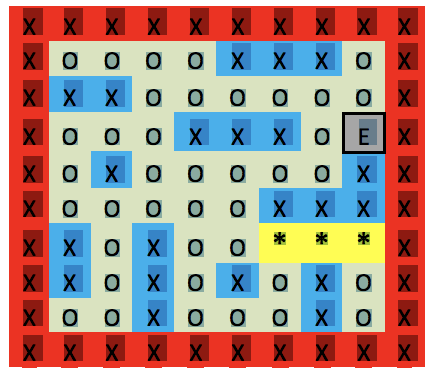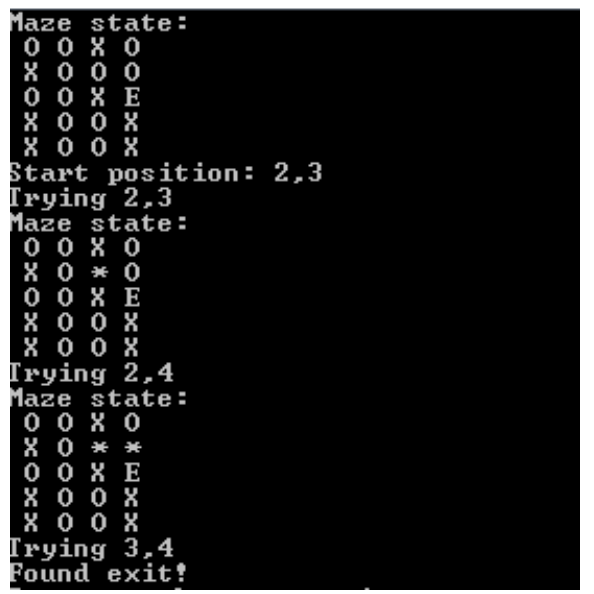Question
Objctivs: 1) Us rcursion; 2) Undrstand and apply backtracking; 3) Us STL containr; Projct dscription: Writ a C++ program that, givn a starting point, finds
Objctivs: 1) Us rcursion; 2) Undrstand and apply backtracking; 3) Us STL containr;
Projct dscription: Writ a C++ program that, givn a starting point, finds its way out of a maz. Th mazs map will b rad from a fil at th start of th program. Your cod must work for all lgal mazs.. Th maz is a rctangular grid rprsntd as a 2D array, and th xit (if thr is on) should b placd on an outr row or column of th play ara. Th program should run until th xit to th maz is found or until it is dtrmind that thr is no xit (aftr xploring all travrsabl clls). xploration of th maz is don by rcursivly invoking a function and marking th clls visitd with a spcial charactr (an lctronic brad crumb to kp from rvisiting xplord clls). Th lgal movs ar to clls adjacnt but not diagonal to th cll currntly occupid. Candidats for th nxt mov ar clls that ar travrsabl and hav not bn prviously visitd. If th spcially markd xit cll is ncountrd th gam should xit with a mssag that th xit was found. Othrwis, aftr xploring th whol maz, a mssag is output stating that thr is no xit.

At lft is an instanc of a maz. Not th attributs of a lgal maz:
X marks non-travrsabl clls Th clls in rd ar not part of th maz map rad from th fil. Thy mark th boundary of th maz, and must b rprsntd as not travrsabl. Th actual play ara has 2 fwr columns and 2 fwr rows than th 10x10 maz map array (i.. you will rad a maximum 8x8 play ara from th fil). Blu squars ar walls.
* (yllow) shows travrsabl clls that hav bn prviously visitd and should not b rvisitd whn locating th xit.
O clls (grn) ar travrsabl clls that hav not bn visitd. All travrsabl clls must b rachabl from any othr travrsabl cll
marks th xit (outlind gray cll) If it xists, It must b placd on on of th outr rows or columns of th play ara. Th xit must b rachabl from any travrsabl clls in th maz (it cant b containd within walls).
Rquirmnts:
1. Your program must b split into 3 fils. Thr will b a class (with sparat intrfac and implmntation fils), and a drivr fil. Th rquirmnts for ths ar spcifid blow:
Th Maz class This class rprsnts a maz
Fils must b namd maz.h and maz.cpp
Class must b namd Maz
Th intrfac (hadr fil) is providd.
You should implmnt th intrfac fil in a .cpp implmntation fil
All data mmbrs must b of th typ spcifid in th hadr fil
All mmbr functions in th intrfac fil must b implmntd as dclard Howvr you hav flxibility in how you choos to implmnt ach
Th constructor will accpt a fil argumnt and will opn and rad th fil and construct th maz. Th fil contains a rctangular maz no largr than 8 clls by 8 clls (your cod must b abl to handl smallr mazs having a minimum of two rows or two columns). Th first lin in th fil has th dimnsions of th maz (# of rows followd by # of columns sparatd by a spac). An xampl maz fil (5 rows by 4 columns) is shown blow. Not: Thr ar no spacs btwn cll lgnd symbols in th input fil.
5 4
OOXO
XOOO
OOX
XOOX
XOOX
Th Print() function should output th mazs currnt stat to th scrn (using th lgnd dscribd abov and including clls visitd thus far). S sampl output.
Function GtStartPt() rturns a random starting point from th travrsabl clls in th maz. Th coords data mmbr should b usd to slct this point.
Th Findxit() function is a rcursiv function that xplors th maz. It has two int paramtrs indicating th playrs currnt row and column (in that ordr), and a bool rfrnc variabl that rprsnts whthr or not th xit has bn found. You should considr th 4 qustions to ask whn planning to us rcursiv algorithms, as you dsign your approach:
How ar smallr instancs of th problm dfind?
How dos ach rcursiv call mak th problm instanc smallr?
What condition(s) can srv as th bas cas(s)?
Will th smallr instancs of th problm rach th bas cas(s)?
A drivr, or clint, fil
Must b namd proj5.cpp
Must contain th lin srand(1000); as th first lin of th main function
Must dclar th fil objct containing th maz map. This fil must b namd maz.txt, and must b in th sam foldr as th sourc fils.
Must instantiat maz, obtain th starting point, and invok th Findxit function.
Th output from th Findxit function should b usd to dtrmin if th xit was found, or if th maz containd no xit. Th appropriat mssag should b output bfor xiting th program.
2. Sampl output:
a) This output show program xcution for th sampl grid prsntd abov, with th playr starting at cll 2,3 (Not: th ordr of sarching adjacnt clls impacts th path takn to th xit).

//Maze.h
#ifndef MAZE_H #define MAZE_H #include#include struct Coordinate // 2D point consisting of x and y coordinates { double x, y; Coordinate(double px, double py) : x(px), y(py) {} // Constructor with initializer list }; class Maze // Represents Maze class' data and function members { public: Maze(std::ifstream&); // Constructor: takes file object and reads maze map from file void Print(); // Displays the maze and its state Coordinate GetStartPt(); // Returns a randomly chosen maze starting point - use coords member void FindExit(int, int, bool&); // Recursive function that attempts to find the exit private: char maze[10][10]; // 2D array that holds maze - outer columns and rows not traversable int maxRows; // Maximum number of rows - excludes outer walls int maxCols; // Maximum number of columns - excludes outer walls std::vector coords; // holds initially traversable locations on the map }; #endif
00 o o o o o 00 o o o o o
Step by Step Solution
There are 3 Steps involved in it
Step: 1

Get Instant Access to Expert-Tailored Solutions
See step-by-step solutions with expert insights and AI powered tools for academic success
Step: 2

Step: 3

Ace Your Homework with AI
Get the answers you need in no time with our AI-driven, step-by-step assistance
Get Started


